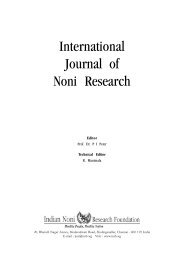International Journal of Noni Research - Noni Family
International Journal of Noni Research - Noni Family
International Journal of Noni Research - Noni Family
You also want an ePaper? Increase the reach of your titles
YUMPU automatically turns print PDFs into web optimized ePapers that Google loves.
21 Intl. J. <strong>Noni</strong> Res. 2007, 2(1-2)<br />
P. Rethinam et al. <strong>Noni</strong> (Morinda citrifolia L.) - the Miracle Fruit - a holistic review<br />
used to produce a yellow or red dye for tapa (cloths) and fala (mats). While<br />
noni fruit is most famous for its role in Polynesian, Melanesian, and Southeast<br />
Asian material medica, there are also numerous ethnobotanical reports <strong>of</strong> its<br />
use as food (Rock, 1913; Wilder, 1934; Brown, 1935; Yuncker, 1943;<br />
Turbott, 1949; Stone, 1970; Degener, 1973; Uhe, 1974; Seemann, 1977;<br />
Whistler, 1992; Krauss, 1993; Terra, 1996). Some reports have indicated its<br />
use was limited to times <strong>of</strong> famine (Krauss, 1993). This, however, is not<br />
correct. The fruit was reported to have been eaten <strong>of</strong>ten by Rarotongans, was<br />
a favorite ingredient in curries prepared by Burmese, and the Australian<br />
Aborigines were known to be very fond <strong>of</strong> the fruit. Captain James Cook <strong>of</strong><br />
the British Navy noted in the late 1700's that the fruit was eaten in Tahiti. In<br />
1769, Sydney Parkinson, one <strong>of</strong> Captain James Cook's crew on the Endeavour,<br />
recorded that Tahitians ate noni fruit. This was likely the 1st written description<br />
<strong>of</strong> its use as a food. More than 2 centuries later, in 1943, the U.S.<br />
government recognized the fruit as edible (Merrill, 1943). There has thus<br />
been ample human experience with eating noni fruit to validate its safety for<br />
human consumption), while the fruit was eaten for health and food (Aragones<br />
et al., 1997).<br />
Traditional Food Use<br />
Morinda citrifolia fruit has long history <strong>of</strong> use as a food in tropical regions<br />
throughout the world. Documentation <strong>of</strong> the consumption <strong>of</strong> the fruit as a<br />
food source precedes the twentieth century. An 1866 publication in London<br />
explained that M. citrifolia fruit was consumed as a food in the Fiji islands.<br />
Later publications described the use <strong>of</strong> this fruit throughout the Pacific<br />
Islands, Southeast Asia, Australia and India. In Samoa, <strong>Noni</strong> fruit was common<br />
fare and in Burma it was cooked in curries or eaten raw with salt. In 1943,<br />
Merrill described M. Citrifolia, L. as an edible plant in a technical manual <strong>of</strong><br />
edible and poisonous plants <strong>of</strong> the Pacific Islands, in which the leaves and<br />
fruits were used as emergency food. In 1992, Abbott reported that <strong>Noni</strong> had<br />
been used as food, drink, medicine and dye. The tribes i.e., Nicobarese are<br />
known to have consumed this fruit raw with salt as well as cooked as<br />
vegetable (Singh et. al., 2005).<br />
Medicinal use <strong>of</strong> Morinda<br />
The Polynesians utilized the whole <strong>Noni</strong> plant for herbal remedies. The fruit<br />
juice is in high demand in alternative medicine for different kinds <strong>of</strong> illnesses<br />
such as arthritis, diabetes, high blood pressure, muscle aches and pains,<br />
menstrual difficulties, headaches, heart disease, AIDS, cancers, gastric ulcer,<br />
sprains, mental depression, senility, poor digestion, arteriosclerosis, blood








